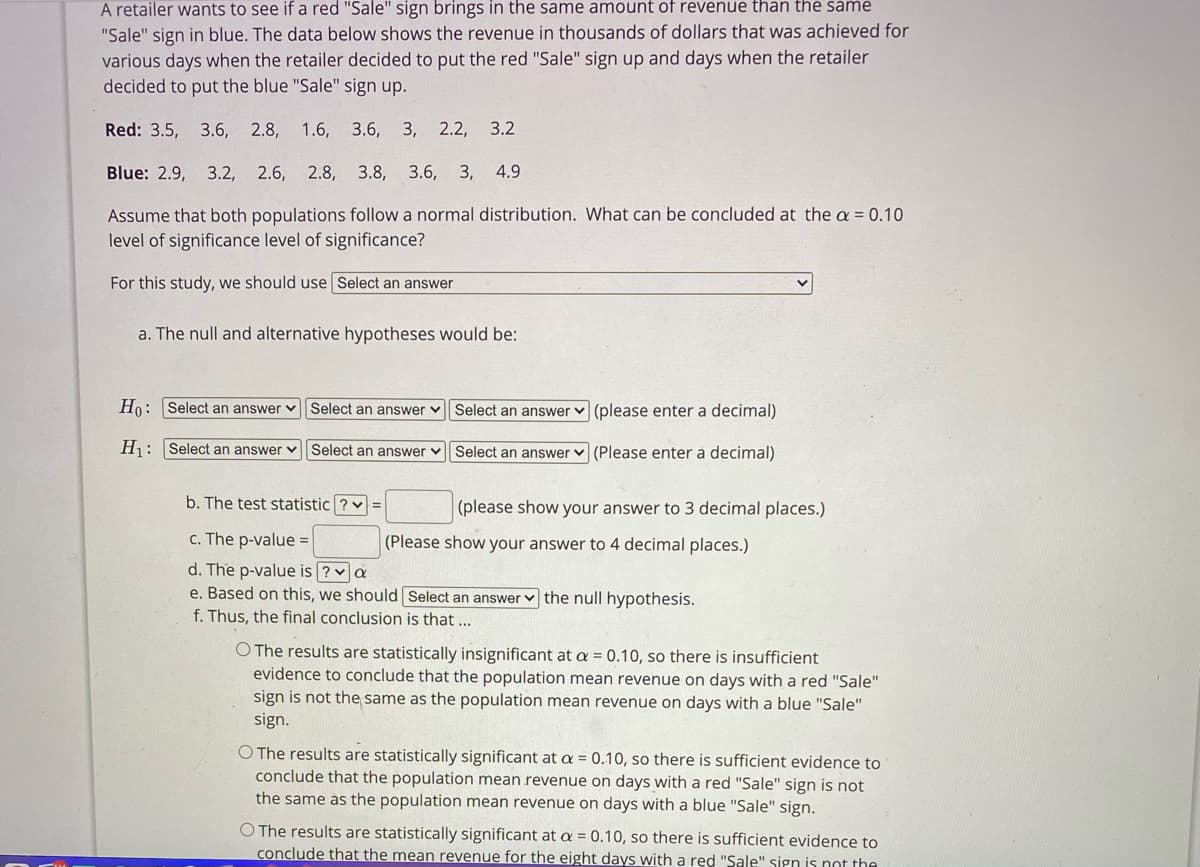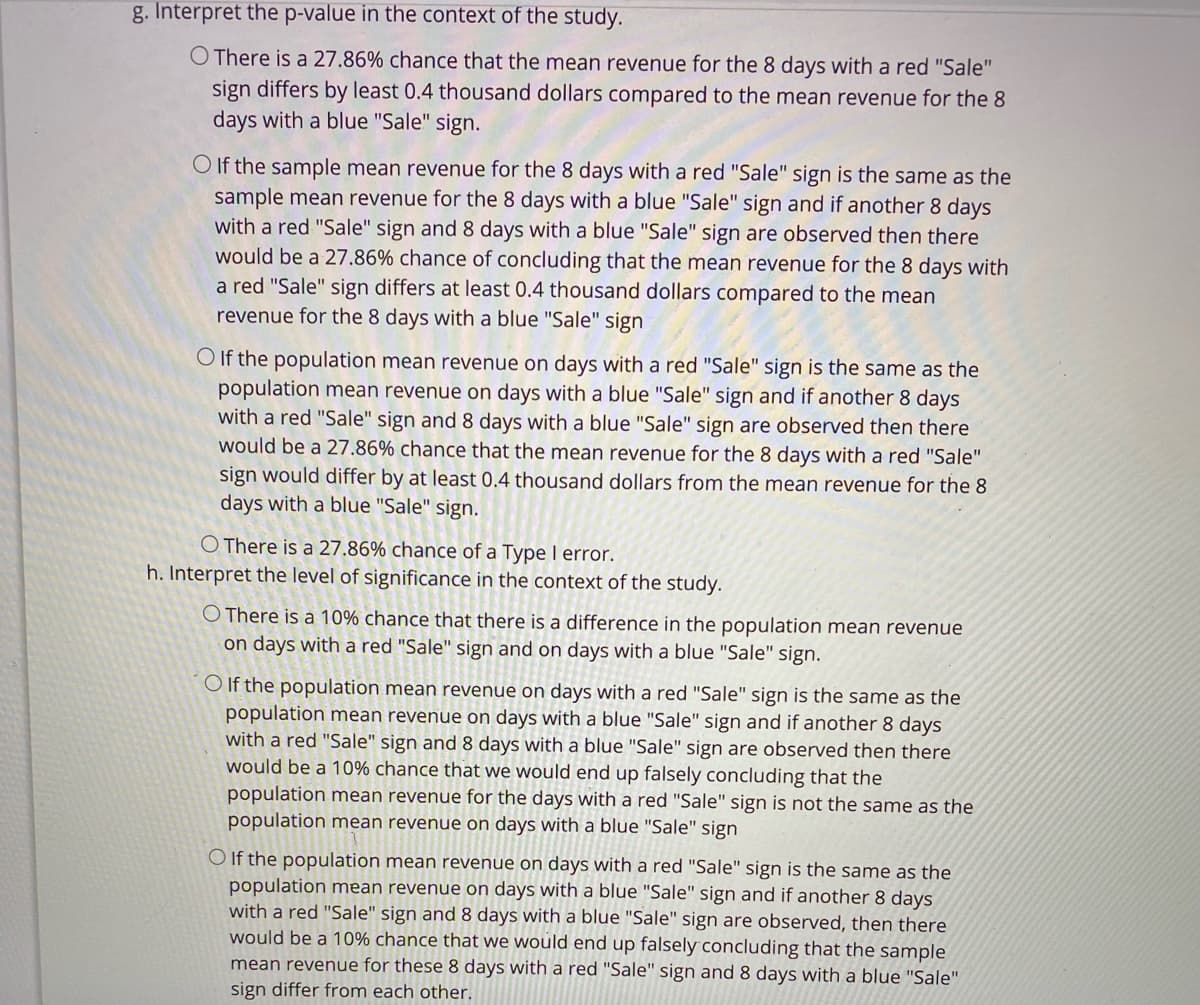A retaller wants to see if a red Sale sigh borings in "Sale" sign in blue. The data below shows the revenue in thousands of dollars that was achieved for various days when the retailer decided to put the red "Sale" sign up and days when the retailer decided to put the blue "Sale" sign up. Red: 3.5, 3.6, 2.8, 1.6, 3.6, 3, 2.2, 3.2 Blue: 2.9, 3.2, 2.6, 2.8, 3.8, 3.6, 3, 4.9 Assume that both populations follow a normal distribution. What can be concluded at the a = 0.10 level of significance level of significance? For this study, we should use Select an answer a. The null and alternative hypotheses would be: Ho: Select an answer v Select an answer v Select an answer v (please enter a decimal) H: Select an answer v Select an answer v Select an answer v (Please enter a decimal) b. The test statistic ? v = (please show your answer to 3 decimal places.) c. The p-value = (Please show your answer to 4 decimal places.) d. The p-value is ? a e. Based on this, we should Select an answer v the null hypothesis. f. Thus, the final conclusion is that ... O The results are statistically insignificant at a = 0.10, so there is insufficient evidence to conclude that the population mean revenue on days with a red "Sale" sign is not the same as the population mean revenue on days with a blue "Sale" sign. O The results are statistically significant at a = 0.10, so there is sufficient evidence to conclude that the population mean revenue on days with a red "Sale" sign is not the same as the population mean revenue on days with a blue "Sale" sign. O The results are statistically significant at a = 0.10, so there is sufficient evidence to
A retaller wants to see if a red Sale sigh borings in "Sale" sign in blue. The data below shows the revenue in thousands of dollars that was achieved for various days when the retailer decided to put the red "Sale" sign up and days when the retailer decided to put the blue "Sale" sign up. Red: 3.5, 3.6, 2.8, 1.6, 3.6, 3, 2.2, 3.2 Blue: 2.9, 3.2, 2.6, 2.8, 3.8, 3.6, 3, 4.9 Assume that both populations follow a normal distribution. What can be concluded at the a = 0.10 level of significance level of significance? For this study, we should use Select an answer a. The null and alternative hypotheses would be: Ho: Select an answer v Select an answer v Select an answer v (please enter a decimal) H: Select an answer v Select an answer v Select an answer v (Please enter a decimal) b. The test statistic ? v = (please show your answer to 3 decimal places.) c. The p-value = (Please show your answer to 4 decimal places.) d. The p-value is ? a e. Based on this, we should Select an answer v the null hypothesis. f. Thus, the final conclusion is that ... O The results are statistically insignificant at a = 0.10, so there is insufficient evidence to conclude that the population mean revenue on days with a red "Sale" sign is not the same as the population mean revenue on days with a blue "Sale" sign. O The results are statistically significant at a = 0.10, so there is sufficient evidence to conclude that the population mean revenue on days with a red "Sale" sign is not the same as the population mean revenue on days with a blue "Sale" sign. O The results are statistically significant at a = 0.10, so there is sufficient evidence to
Glencoe Algebra 1, Student Edition, 9780079039897, 0079039898, 2018
18th Edition
ISBN:9780079039897
Author:Carter
Publisher:Carter
Chapter10: Statistics
Section10.5: Comparing Sets Of Data
Problem 26PFA
Related questions
Question
NEED ANSWER TO ALL ASAP PLEASE

Transcribed Image Text:A retailer wants to see if a red "Sale" sign brings in the same amount of revenue than the same
"Sale" sign in blue. The data below shows the revenue in thousands of dollars that was achieved for
various days when the retailer decided to put the red "Sale" sign up and days when the retailer
decided to put the blue "Sale" sign up.
Red: 3.5, 3.6, 2.8,
1.6, 3.6, 3, 2.2,
3.2
Blue: 2.9, 3.2, 2.6, 2.8, 3.8,
3.6,
3,
4.9
Assume that both populations follow a normal distribution. What can be concluded at the a = 0.10
level of significance level of significance?
For this study, we should use Select an answer
a. The null and alternative hypotheses would be:
Ho: Select an answer v
Select an answer v Select an answer
(please enter a decimal)
Hj: Select an answer v Select an answer v Select an answer v (Please enter a decimal)
b. The test statistic ? v
(please show your answer to 3 decimal places.)
c. The p-value =
(Please show your answer to 4 decimal places.)
d. The p-value is ? a
e. Based on this, we should Select an answer v the null hypothesis.
f. Thus, the final conclusion is that...
O The results are statistically insignificant at a = 0.10, so there is insufficient
evidence to conclude that the population mean revenue on days with a red "Sale"
sign is not the same as the population mean revenue on days with a blue "Sale"
sign.
O The results are statistically significant at a = 0.10, so there is sufficient evidence to
conclude that the population mean revenue on days with a red "Sale" sign is not
the same as the population mean revenue on days with a blue "Sale" sign.
O The results are statistically significant at a = 0.10, so there is sufficient evidence to
conclude that the mean revenue for the eight days with a red "Sale" sign is not the

Transcribed Image Text:g. Interpret the p-value in the context of the study.
O There is a 27.86% chance that the mean revenue for the 8 days with a red "Sale"
sign differs by least 0.4 thousand dollars compared to the mean revenue for the 8
days with a blue "Sale" sign.
O If the sample mean revenue for the 8 days with a red "Sale" sign is the same as the
sample mean revenue for the 8 days with a blue "Sale" sign and if another 8 days
with a red "Sale" sign and 8 days with a blue "Sale" sign are observed then there
would be a 27.86% chance of concluding that the mean revenue for the 8 days with
a red "Sale" sign differs at least 0.4 thousand dollars compared to the mean
revenue for the 8 days with a blue "Sale" sign
O If the population mean revenue on days with a red "Sale" sign is the same as the
population mean revenue on days with a blue "Sale" sign and if another 8 days
with a red "Sale" sign and 8 days with a blue "Sale" sign are observed then there
would be a 27.86% chance that the mean revenue for the 8 days with a red "Sale"
sign would differ by at least 0.4 thousand dollars from the mean revenue for the 8
days with a blue "Sale" sign.
O There is a 27.86% chance of a Type I error.
h. Interpret the level of significance in the context of the study.
O There is a 10% chance that there is a difference in the population mean revenue
on days with a red "Sale" sign and on days with a blue "Sale" sign.
O If the population mean revenue on days with a red "Sale" sign is the same as the
population mean revenue on days with a blue "Sale" sign and if another 8 days
with a red "Sale" sign and 8 days with a blue "Sale" sign are observed then there
would be a 10% chance that we would end up falsely concluding that the
population mean revenue for the days with a red "Sale" sign is not the same as the
population mean revenue on days with a blue "Sale" sign
O If the population mean revenue on days with a red "Sale" sign is the same as the
population mean revenue on days with a blue "Sale" sign and if another 8 days
with a red "Sale" sign and 8 days with a blue "Sale" sign are observed, then there
would be a 10% chance that we would end up falsely concluding that the sample
mean revenue for these 8 days with a red "Sale" sign and 8 days with a blue "Sale"
sign differ from each other.
Expert Solution
This question has been solved!
Explore an expertly crafted, step-by-step solution for a thorough understanding of key concepts.
Step by step
Solved in 3 steps with 5 images

Knowledge Booster
Learn more about
Need a deep-dive on the concept behind this application? Look no further. Learn more about this topic, statistics and related others by exploring similar questions and additional content below.Recommended textbooks for you

Glencoe Algebra 1, Student Edition, 9780079039897…
Algebra
ISBN:
9780079039897
Author:
Carter
Publisher:
McGraw Hill

Big Ideas Math A Bridge To Success Algebra 1: Stu…
Algebra
ISBN:
9781680331141
Author:
HOUGHTON MIFFLIN HARCOURT
Publisher:
Houghton Mifflin Harcourt

Holt Mcdougal Larson Pre-algebra: Student Edition…
Algebra
ISBN:
9780547587776
Author:
HOLT MCDOUGAL
Publisher:
HOLT MCDOUGAL

Glencoe Algebra 1, Student Edition, 9780079039897…
Algebra
ISBN:
9780079039897
Author:
Carter
Publisher:
McGraw Hill

Big Ideas Math A Bridge To Success Algebra 1: Stu…
Algebra
ISBN:
9781680331141
Author:
HOUGHTON MIFFLIN HARCOURT
Publisher:
Houghton Mifflin Harcourt

Holt Mcdougal Larson Pre-algebra: Student Edition…
Algebra
ISBN:
9780547587776
Author:
HOLT MCDOUGAL
Publisher:
HOLT MCDOUGAL
